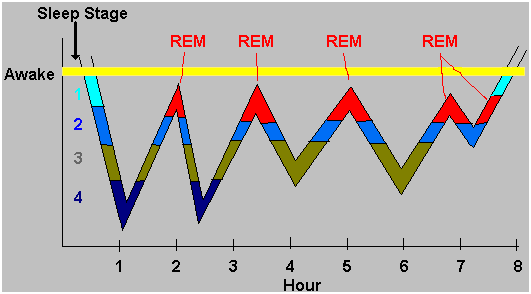Brain Activity during Sleep
What is a dream? The most accessible definition is that it is simply a series of images, sounds, and emotions that are experienced during sleep. What causes dreaming? When the body enters REM sleep, it begins to send signals to different parts of the brain. These signals go through parts of the brain associated with memory and emotions. Though no one knows where dreams originate or what the purpose of dreaming is, many scientists hypothesize that it is the result of the highly active, yet random, neuronal firings. These scientists would speculate that dreams are your brain trying to make sense of random emotions and memories. For example, being fearful because you dream that you are lost in the woods might simply be the brain stimulating the fear center at the same time that it stimulates the memory of trees or forests.
Do we dream in color? About 60% of people report that they "always" dream in color. 32% of people report that they sometimes dream in color and only 7.7% of people report that they never dream in color. That means over 92% of people report that they dream in color. Since no one can, at the time of this writing, read your dreams, all of this information is self-reported by survey.
People all over the world tend to dream of the same things. In a scientific analysis of over 1,000 dreams, researchers found that most dreams are based on emotions (primarily anxiety), sexual themes (about ten percent of dreams in adolescents and about eight percent in adults), and personal experiences from the last day or week. Over 65% of people report that they have recurring dreams.
We spend about 3,000 hours per year sleeping. Sleep has a number of benefits, and a healthy night of it is always a cherished prize. Though we are asleep, our bodies are hard at work repairing themselves. To help you stay asleep, your brain becomes less receptive to outside light or sound stimuli, but if you look inside the brain, you will find the brain itself is quite active (Paraphrased from a Washington University professor).
People with sleeping problems often visit doctors certified by the American Academy of Sleep Medicine (AASM). These technicians monitor the brain's activity during sleep by attaching electrodes to the scalp. A machine, called an electroencephalograph (EEG), records the brain activity during sleep. Other tests monitor eye activity and can provide additional information about REM sleep.

The Stages of Sleep. ©University of Washington.
There are five stages of sleep. Stages one through four range from light sleep to deep sleep, and stage five is REM sleep. REM is one of the lightest stages of sleep. REM sleep occurs about every two hours throughout the night. During REM, the brain stops stimulating the brain's motor cortex. This prevents dreams from causing potentially dangerous movements of the body. Directly after REM, the body descends into a deep sleep. Eventually, sleep will lighten and REM will occur again.
We are not aware of these stages while we sleep. When we wake, we often do not remember our dreams. We rely on machines like the electroencephalograph (EEG) to offer scientists clues about the stages of sleep.